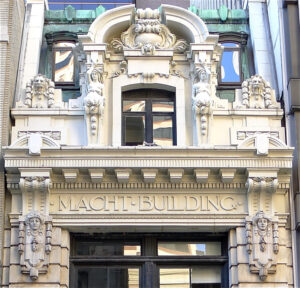
View from the Shot Tower at night. Image courtesy the author.
During the Cuban Missile Crisis you were a designated bomb shelter. A large number of city residents were expect to survive an expected Soviet strike by sheltering within your walls, which are four and a half feet thick at the base. During a Zombie Apocalypse I intend to ride out the crisis atop your battlements, for your walls provide protection not only against the undead horde, but also against extreme cold and heat. During the last polar vortex your interior temperature was between 20 to 30 degrees warmer than the outside. In summer months your temperature ranges between the mid 70s and the low 80s.
But my love of you isn’t based on the survivability you offer against real or imagined disasters. The best part of my job is when it requires me to climb to your top to perform work, which allows me to gaze upon Baltimore. I have posted a number of pictures from atop your battlements on my Twitter feed and on my employer’s Facebook page, but they fail to capture the majesty of your view. A quick 360 turn atop of you immediately introduces a person to many of Baltimore’s triumphs and failings.
On a clear day you can see the St. Leo’s Catholic Church, Johns Hopkins Hospital, TV Hill, the Washington Monument, Harbor East and M&T Bank Stadium. At night, you can see St. Agnes Hospital’s cross and watch Baltimore City Police Department’s Foxtrot units chase down suspects. When the Ravens play at home, you can see the discharge of fireworks that accompanies the entry of the players on to the field. In terms of scope, when I stand on top of you, I can see all the way from the Inner Harbor to Dundalk, to Towson, and south to the Key Bridge. Baltimore’s failings are displayed as well. The post-apocalyptic Old Town Market is prominent feature of your eastward view. Abandoned homes are easily spotted.
In addition to a spectacular view, you have a fascinating history. After being used for the manufacture of shot from 1828 to 1892, you adapted for reuse. In the early 20th century, political advertising and advertising for local civic events was conducted from your battlements. During the First World War, Baltimore’s progress towards fulfilling its quota for the Liberty Loan campaign was tracked via four 200-foot thermometers affixed to your sides. In 1929, you were restored, and a steam-and-light show was installed. An engine pumped steam through a pipe inside you; when the lights were turned on, you transformed into a giant beacon, lighting up the surrounding area. In September 1976, you took on your current role as a public museum and my current place of my employment.
-Matt Hood
When I am not interpreting the history of the Phoenix Shot Tower for Carroll Museums, Inc., I am a para-educator for Baltimore County Public Schools.
Submit your own Love Letter today! Visit http://baltimorearchitecture.org/love-letters-to-baltimore-buildings/ for more details.


